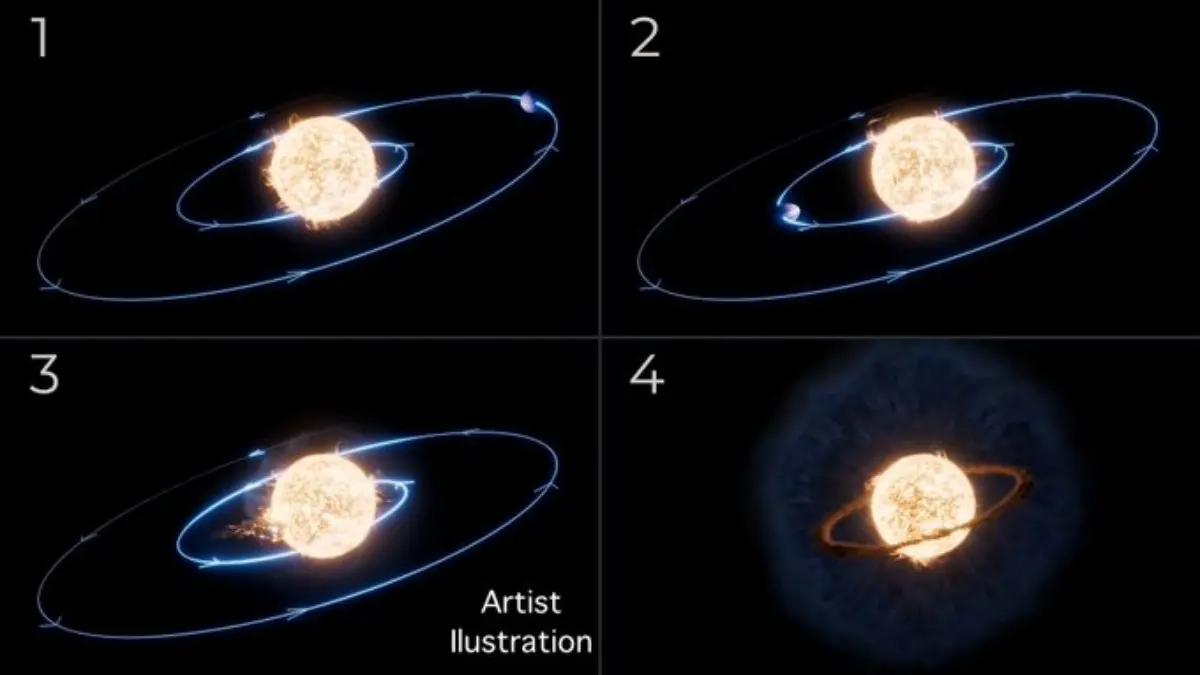Updated 10 April 2025 at 21:35 IST
NASA’s Webb Telescope Catches First-Ever Death of a Planet — But It Didn’t Happen the Way Scientists Thought
NASA’s James Webb Space Telescope revealed that the first star believed to have swallowed a planet did not expand to engulf it as previously thought.
- Science News
- 4 min read

In a stunning twist, new observations from NASA’s James Webb Space Telescope (JWST) revealed that the first star believed to have swallowed a planet did not expand to engulf it as previously thought. Instead, the planet’s orbit gradually shrank over time, drawing it closer to the star until it was ultimately consumed.
The revelation came from a detailed study led by Ryan Lau, astronomer at NSF NOIRLab in Tucson, Arizona, who said, “Because this is such a novel event, we didn’t quite know what to expect when we decided to point this telescope in its direction. With its high-resolution look in the infrared, we are learning valuable insights about the final fates of planetary systems, possibly including our own.”
Image A: Planetary Engulfment Illustration

Webb’s Instruments Rewrote the Story
Using two of Webb’s instruments — MIRI (Mid-Infrared Instrument) and NIRSpec (Near-Infrared Spectrograph) — researchers conducted what they called a “post-mortem” of the star system, located about 12,000 light-years away in the Milky Way galaxy.
The star, which was originally observed in a bright flash called ZTF SLRN-2020 by the Zwicky Transient Facility in California, was believed to have entered its red giant phase and swelled to engulf a Jupiter-sized planet. Initial data from NASA’s NEOWISE mission had shown the star brightening in infrared a full year before the visible flash, suggesting the presence of surrounding dust.
Advertisement
But when Webb turned its powerful infrared eyes toward the system, its instruments painted a different picture. Webb’s MIRI revealed that the star had not brightened to the levels expected of a red giant. The absence of expected swelling signaled that the planet was not engulfed by an expanding star, but rather dragged inward over millions of years until it spiraled into the star.
Planet’s Fall Was a Slow Death Spiral
The planet, estimated to be Jupiter-sized, once orbited very close to the star — even closer than Mercury is to the Sun. Over time, gravitational forces pulled it closer until it began to interact with the star’s outer layers.
Advertisement
Morgan MacLeod, from the Harvard-Smithsonian Center for Astrophysics and MIT, explained, “The planet eventually started to graze the star's atmosphere. Then it was a runaway process of falling in faster from that moment. The planet, as it’s falling in, started to sort of smear around the star.”
As the planet crashed into the star, it ejected gas from the star’s outer layers. That gas cooled and formed cold dust in the months that followed, marking the planet’s final demise.
Dust and Gas Left Behind Told a Complex Story
While scientists expected to find a cool, expanding cloud of dust, what they didn’t anticipate was what Webb’s NIRSpec uncovered — a hot disk of molecular gas orbiting close to the star. Among the molecules detected was carbon monoxide, which hinted at violent mixing in the star’s environment after the planet’s fall.
Colette Salyk, an exoplanet researcher at Vassar College and co-author of the paper, expressed her surprise: “With such a transformative telescope like Webb, it was hard for me to have any expectations of what we’d find in the immediate surroundings of the star. I will say, I could not have expected seeing what has the characteristics of a planet-forming region, even though planets are not forming here, in the aftermath of an engulfment.”
A New Frontier in Planetary Deaths
These observations were part of Webb’s Guaranteed Time Observation program 1240, specifically designed to explore mysterious, sudden infrared brightening events. The findings were published in The Astrophysical Journal.
Lau emphasized the importance of this discovery, stating, “This is truly the precipice of studying these events. This is the only one we've observed in action, and this is the best detection of the aftermath after things have settled back down. We hope this is just the start of our sample.”
Future missions, including the Vera C. Rubin Observatory and NASA’s Nancy Grace Roman Space Telescope, are expected to track similar events by repeatedly scanning wide areas of the sky to detect these rare planetary endings.
Webb Continues to Rewrite the Universe
The James Webb Space Telescope, a collaboration between NASA, ESA (European Space Agency), and CSA (Canadian Space Agency), remains the most powerful space observatory ever launched. It is solving long-standing mysteries of the solar system, exploring exoplanets, and investigating the origins and evolution of galaxies.
This groundbreaking study not only reshaped the understanding of how stars consume planets but also gave scientists a glimpse of what could happen to our own solar system billions of years from now.
Published By : Medha Singh
Published On: 10 April 2025 at 21:35 IST
